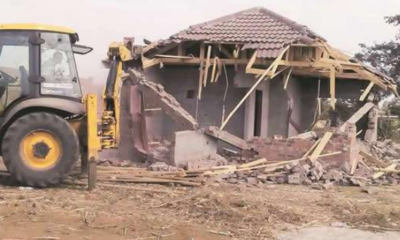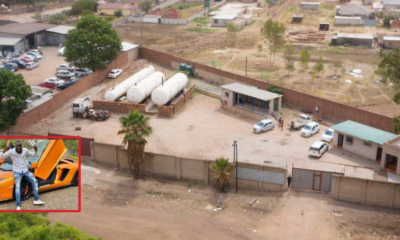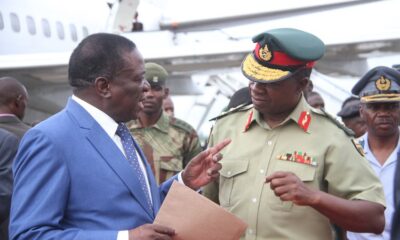News
Zanu PF’s corrupt election funding exposed
Published
3 years agoon
By
NewsHawksTHE ruling Zanu PF mortgaged the country’s natural resources in lieu of US$100 million in financial support ahead of the country’s 2013 general elections, a new report by a local watchdog has shown.
DUMISANI NYONI
Party-state conflation has partly helped Zanu PF maintain its stronghold on national politics.
The explosive report, titled Mortgaging the Future in Return for Power: Zimbabwe’s Natural Resources and the 2018 Election by the Centre for Natural Resource Governance (CNRG), a Zimbabwean civil society organisation, shows Zanu PF is using natural resources to retain power.
CNRG said official documents gleaned by the natural resources watchdog covering the 31 July 2013 elections provide a glimpse into how Zanu PF election funding is sourced and the individuals or companies responsible for underwriting its huge election expenses.
For instance, a Joint Operations Command (Joc) “Election Brief Meeting” report dated 3 June 2013 and referenced “JOC/RG/SS”, reveals that Zanu PF contracted Nikuv International Projects which worked with the Chinese Communist Party (CPC) to strategise on Zanu PF’s 2013 election campaign.
Nikuv drew up a US$3 billion budget for the 2013 elections, the report says.
According to the report, a great part of the budget, 67%, which amounted to US$2.01 billion, went towards “the presidential campaign”, while US$990 million went towards “regional diplomacy” to drum up “support for poll credibility before, during and after elections.”
“The so-called ‘regional diplomacy’ is nothing but a euphemism for bribes paid to the Sadc chairperson and liberation movements in the Sadc region to proclaim legitimacy to the elections whose credibility Zanu PF anticipated was going to be questioned,” the report says.
The same Joc meeting report revealed that part of the US$3 billion came in the form of “US$800 million from Mbada Diamonds and Anjin (Pvt) Ltd”, US$85 million from then President of the Democratic Republic of Congo (DRC) Joseph Kabila, while Equatorial Guinea chipped in with US$92 million.
Other individuals, Mohamed Mussa (late Harare businessman) and British-born property mogul Nick Van Hoogstraten donated US$2 million and US$3 million, respectively.
The other chunk, the report shows, was covered in kind through donations from Sino-Zimbabwe’s then chairperson Sam Pa, Meikles and the CPC. Pa pledged two million T-shirts and a corresponding number of caps and bandanas while Meikles and the CPC donated 500 trucks.
“The balance, as shown by another report from the CIO director-general’s office, was raised through shady sales of Marange diamonds to mainly ‘Mr Sam Pa’ and ‘China-Sonangol’,” the report reads.
“The internal document from the CIO director-general’s office, ‘Ref/23/13/1432’ dated 23 May 2013, shows that a total of 16 000 carats were shipped out of Zimbabwe to Angola and Hong Kong between 04 April 2013 and 10 May 2013, and a total US$58 million was realised from the illicit sale of the gems. A further 20 000 carats were shipped out of Zimbabwe to Angola between 11 and 16 May 2013 for an undisclosed fee,” it said.
“The same internal CIO document clearly states that the money raised was for ‘Special Interest Projects’ (elections) and part of the shipment was taken to Number 88 Queensway, Hong Kong, on behalf of the Special Interest Projects by “Air Vice-Marshal H(enry) Muchena,” who, according to another security document, headed the Zanu PF commissariat together with retired director of counter-intelligence, Sydney Nyanungo. The two, according to the report, also presided over a violent quasi-military operation code-named ‘Operation Return to Zanu PF’.”
Nyanungo was not CIO director counter-intelligence as the report says, but CIO director internal.
According to the Joc internal document, the operation led by Muchena and Nyanungo was funded to the tune of US$800 million from Mbada Diamonds and Anjin (Pvt) Ltd.
“The 2013 funding model was not a flash in the frying pan as Zanu PF also used mineral resources and external donors to fund its 2008 and 2018 elections. In the run-up to the 2008 Presidential run-off election, on 10 April 2008, while President Robert Mugabe, backed by the army, was still refusing to release election results and preparing for a bloody presidential election run-off on June 27 2008, Zanu PF received a US$100 million electoral lifeline from a dubious deal orchestrated by one businessman with interests in farming, the fuel industry and mining,” it says.
“An informant privy to the deal alleged that the money was paid by this businessman to Zanu PF through a ‘loan’ from a company called Lefever Finance Limited (BVi) which had a joint venture operation with ZMDC called Todal Mining (Pvt) Limited which owned Bokai mine,” the report says.
Lefever Finance Limited had 60% shares in Todal Mining (pvt) Limited, while the ZMDC owned the other 40%.
According to the Zanu PF informant as stated by the report, the money was used to finance the campaign by the army to subvert the March 29 2008 election result in favour of Zanu PF through the June 27 2008 presidential election run-off from which MDC’s late founding leader Morgan Tsvangirai pulled out, citing the murder of more than 200 of his supporters by the army.
The Zanu PF informant revealed that the Bokai Mine (Todal Mining (Pvt) Limited) deal points to the fact that the mine was “sold” for US$175 million to the Central African Mining and Exploration Company (Camec) through an intricate web of shelf companies registered in the British Virgin Islands (BVi).
“Zanu PF, through ZMDC, benefitted from a quick fire of US$100 million from the sale which they used for the bloody June 27 2008 presidential election run-off.
“The same source revealed that Billy Rautenbach, through Meryweather Investments Limited (BVi), got US$75 million from CAMEC in addition to coking coal mining rights in Hwange Western Area that he was given by the government of Zimbabwe for arranging the deal,” it says.
“Within a month of the sale of Bokai mine to Camec, Camec valued the same mine at US$1 billion. This means that the government of Zimbabwe was prejudiced of US$825 million because of the illegal and desperate sale of the mine.”
According to Henricus Funnekotter’s International Monetary Fund letter, government and its Zanu PF functionaries who were behind the sale of the mine did not care much about its actual value.
This was because the government had fraudulently acquired it through arm-twisting mining giant Anglo American to cede 30% of its platinum claims on the Great Dyke to the government in an agreement signed on 23 March 2008, days before the presidential election.
In return, Funnekotter says Anglo American was to receive a special mining lease that allowed it to hold offshore foreign exchange earnings from its Unki platinum mine and protection from any future indigenisation requirements on top of the release of its funds that were being held by the Reserve Bank of Zimbabwe.
Funnekotter also reveals that a series of offshore companies registered in the British Virgin Islands (BVi) were used to convolute and obfuscate the deal in clear attempts aimed at hiding the real beneficiaries, who were not the people of Zimbabwe, but the Zanu PF party which was in need of money to overturn an electoral loss through a 27 June 2008 presidential election run-off.
As former US ambassador to Zimbabwe James McGee noted, these “shadowy deals” with investors “with no experience” and “away from public tender” and “scrutiny”, are a preferred modus operandi by the Zanu PF government and its accomplice, the ZMDC, when there is a need to fund the party for elections.
The figure of US$100 million constantly pops up in these “shadowy deals” as shown in the Marange diamond deal, the report say.
While Zanu PF sold Bokai Mine to Camec for US$100 million to fund the bloody 27 June 2008 presidential run-off, the report notes that a similar arrangement with The New Reclamation Group (Pvt) Limited (Reclam), a company “not involved in mining” and without “diamond mining as part of their vision,” was entered into by the ZMDC to exploit the diamond reserves in Marange.
This was reflected in the minutes of the ZMDC board select committee on the due diligence investigation exercise on the approved strategic investors for Marange diamond fields conducted in South Africa on the 4th and 6th of August 2009.
Reclam, which was not a mining company, got the nod to partner the ZMDC’s Marange Resources to form Mbada Diamonds which proceeded to mine the Marange gems in Manicaland.
“Part of the deal involved Reclam, the investor, to ‘capitalise the Joint Venture Company (Mbada Diamonds) to the tune of USD100 000 000, until such amount is exhausted’. New Reclam went on to register a shelf company in Mauritius, Grandwell Holdings, which then entered into a JV (joint venture) with Marange Resources to form Mbada Diamonds,” it says.
According to a 2016 lawsuit by Grandwell Holdings, the cabinet of Zimbabwe endorsed the deal and wrote to Grandwell on 10 February 2010.
“This is to confirm that the Government of Zimbabwe has approved and therefore fully supports the joint venture project between Grandwell Holdings Ltd, a company registered in Mauritius and Marange Resources (Pvt) Ltd a ZMDC investment vehicle, currently carrying on the business of diamond mining under the name Mbada Diamonds (Pvt) Ltd. Appropriate Government approval was duly obtained both for the identification of investor and the subsequent joint venture agreement,” the letter reads.
According to minutes of the ZMDC board select committee cited in the report, the US$100 million was not supposed to “be used to finance the operations” of the joint venture and that the “amounts used to capitalise the Joint Venture Company must not be deducted from cash flow of the company.”
“The informant explained that part of this US$100 million was availed to Zanu PF in 2010 in preparation for the 2013 elections,” the report says.
A Zanu PF insider quoted in the report said Mbada funded most of the activities of the party in the run-up to the 2013 elections and most of the money came from the US$100 million that Robert Mhlanga sourced for the party and the illegal sale of diamonds to Hong Kong.
“What is clear from documents is that the Mbada Diamonds deal, just like the Bokai mine deal that funded the 2008 presidential run-off, was structured in a way that involved a lot of shelf companies registered in the British Virgin Islands to obfuscate the ownership structures in a way to suggest there were a lot of things that ZMDC, the government of Zimbabwe and Zanu PF wanted to conceal,” it says.
“In the same way ZMDC, Zanu-PF and the government of Zimbabwe did with Bokai mine, which was sold to Camec through Lefever owned by Billy Rautenbach’s Meryweather, 50 percent of Marange Resources diamond claims were sold for US$100 million to Reclam which had no mining experience.
“Reclam, because it was not a mining company, immediately transferred its 50% stake in Mbada Diamonds to its subsidiary, Gradwell Holdings Limited registered in Mauritius which also transferred part of its stake to a battery of shelf companies like Transfrontier Mining Company (Hong Kong), Metha Nominees (Hong Kong), Vibury Nominees (Hong Kong), Connetty Nominees (Hong Kong), Express Agents (British Virgin Islands) and Leisure Star (British Virgin Islands).
“The eventual ownership structure of Mbada became so intricate, but very convenient, for the Zanu PF government to move millions of United States dollars, undetected, or at least concealed, in order to illegally fund its operations leading towards the 2013 elections.”
The report notes that after each election, Zanu PF usually gets down to working out strategies to identify corporate bodies and individuals to fund the next elections.
“According to an interviewee involved in the deals, barely six months after the 31 July 2013 elections, in December 2013, Zanu PF, through a proxy who runs most Zanu PF companies, entered into a joint venture operation with Gamstar Holdings, Hannam & Partners and Meikles Group to fund Zanu PF operations in exchange for a raw chrome export licence which was the only one of its kind since the export of raw chrome was banned at the time,” it says.
“The joint venture company Carzle Investments was formed and immediately issued with a raw chrome export licence.
“According to the informant involved in the deal, Carzle Investments shareholders are Meikles Centar Mining (Pvt) Limited 75 %, Cougan Matanhire 12.5%, and Mnangagwa & Sekeramayi Syndicate (M & S) 12.5%.”
Meikles Centar Mining (Pvt) Limited is a Zimbabwean-registered company owned by Meikles Group (51%) and Hannam & Partners (49%). Hannam and Partners is owned by Polish billionaire Ian Hannam and Jan Kulczyk.
Hannam and Partners is represented by Chris Showalter, while Meikles Group is represented by its group financial director Thempson Muzvagwandoga. Zanu PF, using M&S Syndicate, is represented by Sekai Chikwava.
The report shows that, according to the source who was part of the deal, Meikles Centar Mining (Pvt) Limited paid US$2 million to Zanu PF and Matanhire before the Carzle Investments deal could even materialise.
“The source added that US$150 million was then mobilised for actual operations which involved the building of a chrome smelting plant. The source also revealed that the US$2 million was payment for Zanu-PF’s ‘influence’ and Matanhire’s claims,” it says.
“The US$2 million was reportedly paid in through two US$1 million installments. The first installment was paid in cash on 09 December 2013 and distributed as follows: US$450 000 cash paid into a Zanu PF CBZ account on 12 December 2013, while US$200 000 was shared among a trio of Didymus Mutasa, then Acting Minister of Mines, Webster Shamu, Zanu PF National Political Commissar and Sekai Chikwava, the Zanu PF representative in Carzle. The Joint Venture Company was then issued with the only licence to export raw chrome in the country at that particular time.”
The source, according to the report, added that the other US$1 million was paid in on 9 January 2014, but it could not be established how it was distributed. In return for the US$2 million, the source revealed, Mutasa, who was acting Minister of Mines, issued Carzle Investments with a chrome export licence, although the country had banned the export of raw chrome at the time.
“The source revealed that the export licence was, however, later cancelled by then Minister of Mines, Walter Chidhakwa in February 2014 at the height of Zanu PF internal fights but was re-issued on 18 October 2019 after the 2018 elections,” the report says.
“The question arises as to what had happened to warrant the re-issuing of the licence? How much did Carzle shareholders, Hannam & Partners and the Meikles Group contribute towards the 2018 elections which warranted the reissuing of the licence that had been cancelled five years earlier?”
The report says of note was the written instruction in a letter from President Emmerson Mnangagwa to the then Zanu PF secretary of finance Patrick Chinamasa, dated 13 June 2019, shown to the researcher by the interviewee on this matter, imploring the minister “to assist Mr Matanhire with his licence”.
“The question that begs for an answer is what had happened? How much was put into Mnangagwa’s election campaign which warranted his direct interest in the re-issuance of the raw chrome export licence?,” it says.
“While the researcher could not establish the figures that Zanu PF got from its 2018 election dealings with Carzle Investments, a senior Zanu PF official availed figures in the arrangement that Zanu PF entered with businessmen Enock Kamushinda, Ozias Bvute and Rodreck Mlauzi, who the source says provided a total of US$12 million for the Zanu PF 2018 election campaign in exchange for government contracts, key government positions and protection from prosecution.
“The source added that the three businessmen’s US$12 million was used, among other things, to pay for all the campaign billboards for Mnangagwa that were dotted around the country and T-shirts (US$7 million) that were bought from India.”
The report also reveals Mnangagwa was not aware of this huge donation by the three businessmen which went through Local Government minister July Moyo.
The informant revealed that Mnangagwa only got to know about the donation when Bvute and Kamushinda were taken to meet him by a State Residences employee only named as Maburutse.
The report says the businessmen then explained to Mnangagwa how they had funded his campaign and how they expected Bvute to be appointed deputy minister of Finance and to be protected from prosecution in the ongoing National Social Security Authority corruption saga.
Mnangagwa is then reported to have promised the businessmen land and government partnership in a “command housing scheme in preparation for the 2023 election campaign”.
“According to another senior official, Zanu PF also used the quid pro quo strategy to raise funds for the purchase of 60 of the 210 double-cab vehicles that the party procured for its parliamentary candidates in return for the opportunity to front the party in the Great Dyke Investments (GDI) platinum project with Afromet JSC of Russia.
“The source alleged that Kudakwashe Tagwirei bought the 60 cars and was rewarded with an opportunity to buy into the GDI platinum project through his Landela Mining Ventures which now controls 50% of the platinum venture.
“He added that the other 150 of the 210 double cab vehicles were bought by Zunaid Moti with Zanu PF using the same approach of fundraising using the country’s mineral resources, this time, chrome mining fields, that the party availed to Moti in return for the supply of the cars, among other financial donations,” it said.
The recent fallout between Mnangagwa and Moti, reported by online publication ZimLive on 23 September 2019, has provided a window to understanding the extent to which Zanu PF sold vast chrome mining concessions to fund its 2018 election campaign.
“Equally, the fall-out between Moti and Mnangagwa has led to both parties letting out details on the deal that saw Moti getting around 300 hectares of chrome fields in an area between Shurugwi and Zvishabane, in return for buying the 150 election campaign vehicles for Zanu PF.”
The report also says donations from extractive industries were an integral part of Zanu PF’s election funding architecture.
“Because most extractive industries acquire mining rights through Zanu PF, they are required to pay back in cash towards party functions and activities. Fundraising dinners are frequently held by the party where extractive industries are ‘invited’ to donate. They are also expected to provide transport and food for rallies,” it says.
“One CEO of a mining company complained that at times they are forced to build classroom blocks far away from their areas of operation because a provincial political heavyweight is campaigning in that constituency.”
The CEO added that extractive industries find it unnecessary to pay their tax obligations to the government as they would have already paid substantial amounts of money to Zanu PF.
A strong patron-client relationship exists between all extractive industries and the ruling Zanu PF, the report adds.
Recently, the report says, a Chinese company, Beifa Investments, set out to explore for coal in Dinde communal lands in Hwange district. The company was resisted by the locals who argued that the project undermines their environmental, cultural, economic and social rights.
Beifa Investments wrote a letter to Zanu PF Hwange District, not the government of Zimbabwe, complaining that a Zanu PF faction, allegedly linked to the Speaker of Parliament Jacob Mudenda, was inciting the community to resist their activity.
Equally perplexing is the case of Anjin Investments.
In 2016, the late former president Robert Mugabe accused diamond mining firms, including Anjin Investments, of robbing Zimbabwe of an estimated US$15 billion.
Mugabe said of a possible US$15 billion, only US$2 billion had been realised.
However, Mugabe later told journalists the figure was just a guestimate without evidence. He said he had been told by officials.
To cure that haemorrhage, Mugabe formed the Zimbabwe Consolidated Diamond Company (ZCDC) and unsuccessfully tried to force the mining companies to merge.
When they refused, Mugabe forced them out of Marange, claiming that they had “robbed us”.
Mugabe’s claims were barely surprising, given that it was a public secret that Zimbabwe’s diamond revenues were not flowing to Treasury.
Global Witness, a British not-for-profit natural resources watchdog, reported in 2012 that Zimbabwe’s diamonds were funding a parallel Zanu PF government to undermine the work of the Inclusive Government.
Former Finance minister Tendai Biti has repeatedly stated that Anjin Investments was not remitting anything to Treasury during his tenure in the Government of National Unity.
However, barely a year after he ascended to the presidency, Mnangagwa reinstated Anjin Investments in Marange.
“Anjin has been secretly mining and has not declared any statistics or production or revenues generated. It is equally unknown where Anjin sells its diamonds and account to,” the report says.
From the information gathered, the report says it can be concluded that funding for Zanu PF election and political activities chiefly comes from state companies and corporations, private companies, especially in the extractive sector and organisations linked to Zanu PF, wealthy individuals and private entities operating in Zimbabwe, the region and further afield.
You may like








